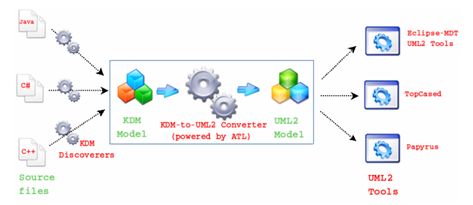Notice: This Wiki is now read only and edits are no longer possible. Please see: https://gitlab.eclipse.org/eclipsefdn/helpdesk/-/wikis/Wiki-shutdown-plan for the plan.
MoDisco/KDM/UMLConverter
The goal of KDM to UML converter plugin is to allow practical transformations of UML models.
Description
This tool aims at converting KDM models into UML models in order to allow integrating KDM-compliant tools (i.e. discoverers) with UML-compliant tools (e.g. modellers, model transformation tools, code generators, etc), as shown in next figure.
The converter is mainly implemented by an ATL model-to-model transformation taking as input a model conforming to the KDM meta model and producing as output a model conforming to the KDM models into UML meta model.
The mapping between KDM and UML is described in the following table:
This mapping can be changed or completed easily by updating the ATL rules.
The converter can also generate a trace file of the transformation to UML and a transformation log.
Requirements
To use the plugin you need:
- JDK 1.5 or above
- a version of Eclipse 3.3 or above with the following set of plugins installed
Install
You will find a version of this plug-in attached in following bug.
As IP review of this plugin is not finished, here is installation instructions :
- Extract archive file in your Eclipse workspace, then use "import" menu to import this project.
- Use "export" menu to export this project as a plugin (Deployable plugins and fragments) in your Eclipse installation. Don't forget to choose "Package plug-ins as individual jar archives" option.
- re-start your Eclipse to take in account this plug-in
User manual
The plugin also provides the user with a contextual menu in order to create easily models. By right-clicking on a KDM model in the Eclipse Package Explorer view you can generate the UML model, with or without traces (see next figure).
Generating UML model from a KDM model
Current Limitations
The bidirectional UML Association elements are not identified by the rules: two complementary unidirectional UML Association elements are generated.


